Suffering

I don’t know where God gets the patience. We are absolutely the most difficult people to communicate with! As the Letter to the Hebrews begins, “Long ago God spoke to our ancestors in many and various ways by the prophets.” Many and various ways – thank you, God, for trying everything you could think of to get through to us. And then, as Hebrews continues, “in these last days he has spoken to us by a Son.” And not just any, run-of-the-mill offspring. No! This Son was “appointed heir of all things,” by God, “through whom he also created the worlds.” Sending such a magnificent messenger means nothing less than a passionate desire to be heard: I AM SENDING YOU MY SON, THE ONE THROUGH WHOM I DO MY GREATEST WORK TO SHOW YOU WHO I AM! IS ANYONE LISTENING??
That was two thousand years ago and still God has not abandoned hope. At least I think God hasn’t! Which is so like God. But what is so not like us is that finally, tentatively, it appears that we are beginning to get the message. At least a part of the message that has not gotten through to us before. A Spirit of renewal has been moving through Christianity. New meanings are being discovered in Scripture, meanings that are so strange and unnatural to us that they could only have come from God. Or should I say, that they could only have been coming from God for a long, long time until we finally developed ears to hear.
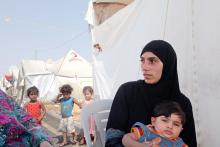
I wish I could sit beside you on a cushion on the floor and have a cup of tea with you. I would like to snuggle your baby in my arms. I would like to hear your story. I know you have a sad story, and if I heard it, I would weep.
I know you are good and loving women. I’m sorry you have lost so much. I’m sorry you had to come to a country, a city, and a house that is not yours.
I can imagine you in your own country, strong women serving others. I can imagine you making beautiful food and sharing it with your family and friends. I can imagine you caring for your mothers and daughters, fathers and sons, sisters and brothers and friends. Just the way I do.
Because that’s what women do. We are compassionate. We give. We serve. We protect. We work hard to make the world better for the people we love.
Wherever I go in the world, I discover that we women are very much alike. We may have different clothes. Different languages. Different cultures. Maybe our skin is a different color. But in our hearts, we are the same.
That’s why we can look into each other’s eyes and feel connected. We can talk without using words. We can smile. We can hug. We can laugh.
And sometimes, we can feel each other’s pain. I have prayed that God would help me feel your pain. I wish I could remove your pain. I wish I could help you carry it.
The recent focus on the kidnapped girls in Nigeria shines a light on the suffering of women and girls all around the world.
Perhaps it is due to my ongoing fascination with Jewish and Christian apocalypses that the motif of suffering is constantly on my mind. I am always struck with John the Seer’s words of praise and encouragement in his letters to the seven churches of the Apocalypse that are patiently enduring persecution, affliction, distress, and tribulation.
It seems that from a Christian perspective, suffering is to be expected and just part of the deal of Christian membership — a real scriptural blow to prosperity gospels! Thus it should come as no surprise to us when the letter of 1 Peter 4:12-14 and 5:6-11 emphasizes the same themes of present suffering as a marker for future reward.

Don’t you hate it when you accidentally slice the tip of your finger on one of your knives and the cut is deep enough to draw blood? Or when one of the cats gets a little too playful with the claws and you’re soon looking for a bandage?
Nobody likes to bleed, even though bleeding is part of life. To live is to bleed. If we’re not bleeding, we’re not living.
We all bleed lots of times, in lots of ways. We skin our knees and scrape our emotions. We often have to head for the medicine cabinet for a bandage. Sometimes, we feel like we need a tourniquet.
There are the little, daily cuts that we all get. Someone says something that hurts our feelings. Something doesn’t turn out the way that we’d hoped, and we get discouraged. A project that we’ve invested so much of ourselves into gets rejected, and we feel rejected, too.
It happens all the time.
Sometimes, we wind up with a deep spiritual cut that needs to be stitched closed with the help of others. A relationship ends. A job disappears. A tumor appears. A storm blows through our neighborhood and destroys what we’ve built over the years.
I admire those who learn not only to accept the blood-stained moments, but to embrace them. They develop a capacity to see beyond the momentary hurt. They recognize that bleeding is part of the grand process of life.
And they bleed joyfully.
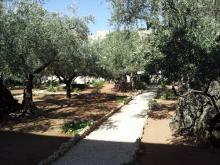
In the Garden of Gethsemane, Jesus utters his agonizing prayer, “Abba, Father, for you all things are possible; remove this cup from me; yet, not what I want, but what you want.”
Who among us hasn’t found ourselves in a situation where the inevitable seems impossible? Where the unavoidable seems unimaginable?
Who hasn’t said to God, in so many words, “Remove this cup”?
The most difficult thing in such a situation may be its crushing inevitability. You want to escape from your life, which suddenly feels like an oncoming train about to run you down. It is the shock you feel when you receive a frightening diagnosis from your physician. When you are laid off from a job. When a friend dies. When a relationship ends. You say to yourself, “This cannot be happening.”

THERE IS NO controlling a story once it’s out. Even in the times before cell phones, the internet, and Twitter, news traveled a similar route through participants, eyewitnesses, and those with the privilege to eavesdrop upon rumors and reports. Details get scattered, but the facts stand out. Many stories can be told about who, when, and how the story leaked. But all those specifics remain secondary to the spectacular announcement. For example, in 1903, how did The Virginian-Pilotscoop other newspapers to be the first to cover the beginning of the aviation age? No one really knows. Orville and Wilbur Wright believed their hometown Dayton newspapers should make the announcement. Indeed, on Dec. 18, the day after the first flight, the Dayton Evening Heraldreported the news—directly based on a telegraph sent by Orville Wright. But three other papers had already reported this world-changing occasion based on TheVirginian-Pilot’s story. Though filled with inaccuracies, the original accounts correctly announced the single important fact: There had been a flight!
Two thousand years earlier, the witness of a few women called forth centuries of testimonies that describe a progression from lack of recognition to full recognition of Jesus the person, as well as the significance of his death and resurrection. The cross and the empty tomb are not self-explanatory; they require interpretation. On the other side of the Lenten journey, Easter provides opportunities for the church to reflect on the biblical witness concerning the rumors of the resurrection. These texts highlight not only the necessity of interpretation, but also the sources and shape of valid interpretation.
![By U.S. Department of State from United States [Public domain], via Wikimedia Commons By U.S. Department of State from U.S., via Wikimedia Commons](https://sojo.net/files/styles/medium/public/blog/Secretary_Kerry_Meets_With_the_Family_of_Kenneth_Bae_%2812194118966%29%20%281%29.jpg)
Today marks Korean-American Christian missionary Kenneth Bae’s 500th day in a North Korean prison. Bae was arrested in November 2012 while leading a tourist group. State-run media reported that he was convicted of attempting to lead a religious anti-North Korean religious coup. He has been sentenced to 15 years of hard labor. Bae is a reminder to all of us that Korea remains divided. Brothers and sisters are separated and friends are divided between the 38th parallel.
I was born in Seoul, South Korea. My mother and father were children during the Korean War, and my mother told me a few stories of how they had to flee during the war. She was a young child, one of eight. My grandmother would gather the children and walk for miles and miles making their way down into southern Korea. As they were fleeing one day, a bullet went through my grandmother’s thigh and created permanent damage to her leg. As a young child, I thought it was a wonderful war story of heroism and courage. I didn’t realize then the agony, fear, and suffering that my parents or my grandparents went through to keep safe and keep alive.
As the Korean War lingered on, it ended with the division of Korea at the 38th parallel. That division is a stark reminder of how a beautiful, lovely country can be filled with pain, sorrow, animosity, and suffering. The 38th parallel has kept family members and loved ones apart for almost 60 years. Many divided families are unable to reunite or unable to know if their relatives are still living and doing well. The heartbreak of living apart in their own country has brought lots of anger, tension, loss, and suffering.
In Korea, people have a term for such suffering: han. Han is a difficult word to translate into the English language. The best way to do so may be through ‘unjust suffering’ or ‘piercing of the heart.’
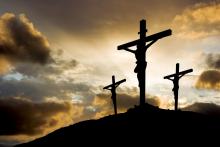
Abram left his homeland on a promise and a prayer. God called. Abram went. The Biblical text makes it seem so simple. There are no signs of struggle or doubt. There is no grief over what is left behind, only the forward look toward a new land and a new future. Leaving home for Abram seems so easy.
As I reflect on this week’s scripture, I’m in Lebanon listening to stories of Syrian refugees who left their countryand their kindred to find a place of refuge. Unlike Abram, they did not leave on the promise that they would become a great nation. They left because bombs fell on their houses. They left because food became scarce. They left because they watched their loved ones die in the rubble as buildings fell to the ground.
As we enter into this season of Lent, it is fitting for us to pause and listen to their stories. Remembering Christ’s suffering is more than an exercise in gratitude. It is a chance for us to stand in solidarity with those around the world who suffer each day. It is a challenge for us to take our own suffering (be it large or small) and connect it to the suffering of others and to the suffering of Christ on the cross.
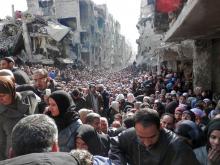
Last week amid the closing of the Olympics, the national debt, and the latest pop culture ‘news,’ this photo was published that encapsulates the volume of pain and suffering that is happening in Syria. For years, the conflict in Syria has gone through its ebbs and flows; it has been in and out of the media’s attention. Even though thousands of people have been displaced and families have been forced to eat animal feed, this is not worthy for American front-page news. Sadly, travesties around the world, or even in our backyard, are categorized as “out of sight, out of mind.” Too often we are consumed by other things than those outside of our limited purview.
When I saw the photo of the suffering of the Syrians, I was shocked; I was shocked that so many people were in line to get food, shocked that despite their best efforts there is not enough food to go around. I felt sad for the people who, by no fault of their own, live in a country that is being ravaged by war, violence, greed, and power struggles. I felt embarrassed for all of the times I whined and complained about my own “problems.” All of them collectively wouldn’t even begin to compare to what people are facing in Syria at this very moment. I wanted to find a way to do something, to raise my voice for them ... anything.

Last year, I wrote about my journey from forcing joy to finding that love is what is everlasting, not joy — that we sometimes hear and believe that Jesus only lives in the places of our lives where we recognize him with joy. But that that is not true.
And so, almost as an afterthought, I've been thinking lately of other ideals that Christians hold as truth, somehow in the process giving a lifeless principle more weight than a Living Christ who reveals himself beyond what can be wrapped up with words and smacked with a theological bow.
Like the concept of Presence.
We know and rest our restless hearts in the idea that Jesus is with us always, lo, even unto the very end of the age. A God who never leaves us or forsakes us. And this is good. We sing songs and pray prayers and feel goose bumps and know that it is true … at least in those moments.
But what about the God who seems to be known by God’s absence as much as by God’s presence? What happens when we don't feel God’s proximity uninterrupted?
Joshua Casteel served as an interrogator in Iraq. Then an encounter with a Jihadist challenged him to truly live out his faith.
THE DOMINANT cultures of North America have long struggled to take responsibility for the suffering and injustice inflicted upon the Indigenous Peoples of the continent. The archetypal “us/them” story of cowboys and Indians remains at the core of North American national identities, from derogatory sports mascots and symbols such as the Washington “Redskins” and the “Chief Wahoo” character of the Cleveland Indians to the ignorant “redfacing” by non-Indigenous partygoers and trick-or-treaters in contrived Indian outfits. And this situation is nowhere near ending, despite many years of cultural sensitivity training and education.
Such overt racism should never be acceptable today. Yet it persists in regard to Indigenous Peoples. Why is this? As one friend remarked to me, most modern-day Americans believe injustices done to Indigenous Peoples to be a thing of the past.
But are they? Steve Heinrichs, director of Indigenous relations for the Mennonite Church in Canada, has brought together nearly 40 theologians, activists, writers, and poets—half of whom are Indigenous—to create Buffalo Shout, Salmon Cry: Conversations on Creation, Land Justice, and Life Together, a challenging anthology on Indigenous-Christian relations, stolen land, racism, and the impending environmental crisis that we all must face together.
LATELY I’VE been reading my dead friend’s files. That’s how I know that he often typed in Cambria. That’s how I know that he drafted beginning-to-end, reworking early paragraphs before he set down the next—which is why so much of his writing just stops. That’s how I know that as a child he held press conferences in a White House made of cardboard boxes, wearing a clip-on tie, and that the night before he began school at West Point (a school he’d soon leave), he and his father smoked cigars on a hill overlooking the Hudson River, though his father did not like cigars. That’s how I know how much he thought about pain, which to Heidegger is “the rift,” a “separating that gathers,” and to Wittgenstein is “a having, not a knowing,” and to Elaine Scarry is an “objectless experience” that “destroys language.”
This thinking was for classes at the University of Iowa and the University of Chicago, and this thinking was for other people, namely prisoners and fellow soldiers in the War on Terror, which was also the Global War on Terrorism, and was the Iraq War and is still the War in Northwest Pakistan and the War in Afghanistan, a subset of which is “Operation Enduring Freedom,” and is also and continues to be World War III or World War IV, depending on how you count, and was once The War Against Al-Qaeda and is now the Overseas Contingency Operation, which has been tidily renamed CVE (Countering Violent Extremism).
Joshua Casteel was sent to the Long War after first enlisting in the Army Reserves as a high school junior in Cedar Rapids, Iowa. Seven years later he was stationed at Abu Ghraib prison as an interrogator and linguist. This is where he became convicted that he could no longer be an “American war fighter,” which he saw as treason against his “real kingdom and home.”
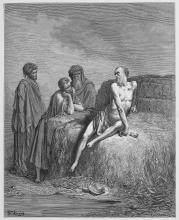
The world of Christian theology has seen its fair share of writings that address horrible suffering and the confusion about God’s character that it causes. The question has been on my mind in light of the Philippines’ calamity. Although satisfying answers are difficult to come by with a topic like this, I offer a few insights that have helped me to continue to trust God’s love. The biblical character of Job shows us how, as believers in a loving God, we should regard and respond to suffering around us.
It no longer surprises me when I hear people express cynicism and doubt about a caring God — I sometimes wonder why more Christians have not done so. Whose faith can remain undisturbed when Typhoon Haiyan kills 5,000 Filipinos and inflicts misery on thousands more? I recall a photo of a woman weeping by her child’s body inside a damaged church. Who can imagine her despair? Can we conceive of the hell endured in the same region by enslaved women and girls who are raped and degraded every day, every hour?
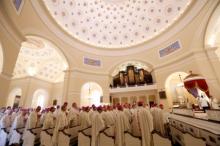
As the U.S. Catholic bishops began their annual fall meeting on Monday, they were directly challenged by Pope Francis’ personal representative to be pastors and not ideologues — the first step of what could be a laborious process of reshaping the hierarchy to meet the pope’s dramatic shift in priorities.
“The Holy Father wants bishops in tune with their people,” Archbishop Carlo Maria Vigano, the Vatican ambassador to the U.S., told the more than 250 American churchmen as he recounted a personal meeting in June with Francis.
The pontiff, he added, “made a special point of saying that he wants ‘pastoral’ bishops, not bishops who profess or follow a particular ideology,” Vigano said. That message was seen as an implicit rebuke to the conservative-tinged activism of the bishops’ conference in recent years.
Almost since his election in March, Francis has signaled that he wants the church to strike a “new balance” by focusing on the poor and on social justice concerns and not overemphasizing opposition to hot-button topics like abortion and contraception and gay marriage — the signature issues of the U.S. bishops lately.
OUR BODIES AND the land are one. Move the earth with your body, dance on it, farm in it, play with it; our final return to it is sacred. The soil is made of clay, like you and me—hydrocarbon molecules, layers of geological and muscular formations, alive. The soil, mountains, and valleys are layered with time like our layered muscle tissue. We dance on the earth in the face of death, for the healing of ourselves and the healing of the land, connected as farmers, dancers, painters, musicians, and lovers of the goodness of the good green earth moving through lament. Our bodies and the earth are one and their healing and grieving are interconnected.
January 2011, around the corner from my house, Anjaneah Williams was murdered, across the street from Sacred Heart Church, pierced in the side, at 2 p.m., walking out from a sandwich shop. It was a Thursday. She died six hours later at Cooper Hospital in the arms of her mother, before the children who deeply loved her. One of the gunman’s stray bullets shot across the street through the stained glass at Sacred Heart. Anjaneah’s death reverberated in the air, an exploding, echoing canyon; a screaming mother in a vacuum, unheard and deafening. Her murder was one of 40 in the neighborhood in the near half-century since the shipyard closed. Forty people on the sidewalks, on the lots where houses once stood, in a neighborhood with 28 known environmentally contaminated sites.

The plight of Job is one of the most familiar stories from the Hebrew Bible. Many of us know Job’s suffering and the tortuous advice of Job’s “comforters.” The experience of suffering is universal. In the midst of our suffering, we seek to understand, to process, to comprehend. For individuals of faith, events of radical suffering plunge us into a theological crisis. Where is God? Is God causing this to happen? Is God allowing this to happen? Why?
The crisis deepens when we realize that the suffering does not match our preconceptions of how the world should work. We seem to think that if we output positive vibes into the world, the world (or God) will reciprocate. That would be fair. That would be right. That would be just.
However, in the reality of human experience we recognize that great fortune sometimes falls on the underserving, while horrible events beat down the most innocent among us.
Perhaps this is why so many of us can relate to the book of Job. Here we have a character who does everything right. From the first verse, we know that Job is “blameless and upright, one who feared God and turned away from evil” (Job 1:1). In fact, these characteristics draw God’s attention and praise.
CYNTHIA MOE-LOBEDA is a Lutheran feminist ethicist trained at Union Theological Seminary in New York who teaches Christian ethics, gender, and diversity studies at Seattle University. The author of several previous books in Christian social ethics, she has emerged as a significant voice in contemporary Christian economic, ecological, and public ethics.
The evil considered in Resisting Structural Evil is primarily the collective ecological and economic damage being done by wealthy global North folk—such as most readers of this review—through the indulgent and wasteful way of life that we have been socialized into accepting as normal despite its disastrous implications and effects. This evil is structural and driven largely by the unaccountable and nearly unlimited power of the modern corporation.
One reason our ecological and economic injustice can be labeled as evil is because it is largely hidden from our eyes—or if we see it, it is accepted as simply the way things are and always have been and always will be. So we live off the suffering of the people whose land we take or despoil, or whose livelihoods we destroy, or whose water we poison, or whose labor we exploit to get our “everyday low prices.” And we go merrily about our wealthy and comfortable way in a state of what the author describes as “moral oblivion.”
Moe-Lobeda takes the reader on a journey intended to end such moral oblivion. I find the book to be primarily an exposé of the connections between the “American way of life” and the injustices on which it is built—and which it perpetuates. Among these injustices is harm to the earth, which has both terrifying long-term implications for the livability of our planet in the future and concrete short-term costs for those invisible neighbors of ours who suffer ecological harm so that we might drink our soft drinks and get the latest electronics.
IN "SILENCE FOR GAZA,” Palestinian poet Mahmoud Darwish captures the contradictions of the coastal enclave, describing it alternately as “ugly, impoverished, miserable,” and “the most beautiful, the purest and richest among us.” Darwish’s antonyms evoke Gaza’s crushing conditions and resilient residents, exemplars of sumud, an Arabic word roughly translated as “steadfast perseverance”—a fundamental form of Palestinian resistance. Darwish’s poem also states that Gaza “did not believe that it was material for media. It did not prepare for cameras and did not put smiling paste on its face.” And yet every person, every story, every image of Gaza illustrates this persistent paradox of a land at once ugly and beautiful.
“I DON’T KNOW why they targeted us. No rockets were fired from our neighborhood,” says citrus farmer Yusuf Jilal Arafat, whose 5-year-old daughter Runan was killed when Israeli warplanes bombed their home. Arafat’s wife, four months pregnant, and their 8-year-old son were found alive in the rubble. His surviving children now suffer from frequent panic attacks at night. Many of Arafat’s trees were destroyed by the bombs, and the ground is covered with oranges now in various stages of decay. Rumors of contamination by Israeli weapons may hurt the sales of his crop, but he will still harvest. The family is living with Arafat’s father-in-law until they can rebuild.
Rebuilding under Israeli import restrictions is no simple task, so salvaging existing materials remains a vital practice—albeit risky, according to structural engineers. But ingenuity-by-necessity is constantly on display in Gaza, whether it’s recovering crushed stone from beneath ruined highways, straightening steel rebar from bombed-out buildings, or pulverizing concrete for reuse in new (but weaker) blocks.
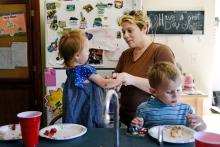
Sarah Decareaux was lying on the cold, concrete floor of a barn.
She closed her eyes, curled her knees into her chest, and told herself that what was happening wasn’t real.
She felt claustrophobic. She was having trouble breathing. Her vision tunneled, the same way it had when she’d been in labor. She could see only a few feet in front of her.